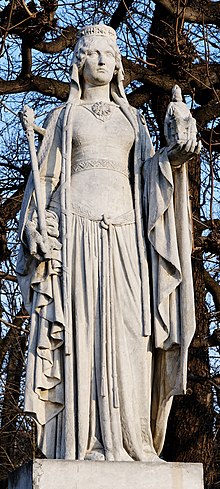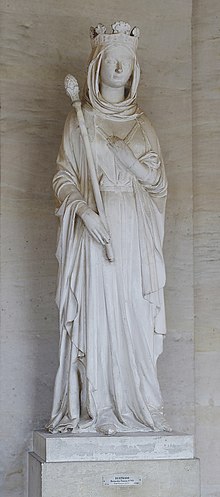| Bertrada of Laon | |
|---|---|
 Statue of Bertrada by Eugène Oudiné, one of the twenty Reines de France et Femmes illustres in the Jardin du Luxembourg, Paris | |
| Queen consort of the Franks | |
| Reign | November 751 - 24 September 768 |
| Born | between 710 and 727 Laon, Francia |
| Died | 12 July 783 Choisy-au-Bac, Francia |
| Burial | |
| Spouse | Pepin the Short |
| Issue | |
| Father | Charibert of Laon |
| Religion | Roman Catholicism |
Bertrada of Laon (born between 710 and 727 – 12 July 783), also known as Bertrada the Younger or Bertha Broadfoot (cf. Latin: Regina pede aucae, i.e. the queen with the goose-foot), was a Frankish queen. She was the wife of Pepin the Short and the mother of Charlemagne, Carloman and Gisela, plus five other children.
Nickname[edit]
Bertrada's nickname "Bertha Broadfoot" dates back to the 13th century, when it was used in Adenes Le Roi's trouvère Li rouman de Berte aus grands piés.[1] The exact reason that Bertrada was given this nickname is unclear. It is possible Bertha suffered from bunions, her feet became misshapen and spread because of them. It is also possible but unlikely that Bertrada was born with a clubfoot,[2] although Adenes does not mention this in his poem.[1]
Biography[edit]
Early life and ancestry[edit]
Bertrada was born sometime between 710 and 727 in Laon, in today's Aisne, France, to Count Charibert of Laon.[3] Charibert's father might have been related to Hugobertides.[4][5] Charibert's mother was Bertrada of Prüm, who founded Prüm Abbey along with Charibert.
Marriage and children[edit]
Bertrada married Pepin the Short, the son of Charles Martel, the Frankish "Mayor of the Palace", in 741. However, Pepin and Bertrada were too closely related for their marriage to be legal at that time; the union was not canonically sanctioned until 749, after the birth of Charlemagne.[6]
According to French historian Léon Levillain, Bertrada was Pepin's first and only wife.[7][8][9] Other sources suggest that Pepin had previously married a "Leutberga" or "Leutbergie", with whom Pepin would have had five children.[10]
Bertrada and Pepin are known to have had eight children: at least three sons and at least four daughters. Of these, Charlemagne (c. 742 – 814),[11] Carloman (751–771)[12] and Gisela (757–811) survived to adulthood. Pepin, born in 756, died young in 762. Bertrada and Pepin also had Berthe, Adelaide, and Rothaide. Gisela became a nun at Chelles Abbey.[13]
Queen of the Franks[edit]

In 751, Pepin and Bertrada became King and Queen of the Franks, following Pepin's successful coup against the Frankish Merovingian monarchs.[14] Pepin was crowned in June 754, and Bertrada, Charlemagne, and Carloman were blessed by Pope Stephen II.[15][16]
After Pepin's death in 768, Bertrada lost her title as Queen of the Franks. Charlemagne and Carloman inherited the two halves of Pepin's kingdom. Bertrada stayed at the court and often tried to stop arguments between the two brothers.[12] Some historians credit Bertrada's support for her elder son Charlemagne over her younger son Carloman, and her diplomatic skills, for Charlemagne's early success.[17] Although her influence over Charlemagne may have diminished in time, she lived at his court, and, according to Einhard, their relationship was excellent. Bertrada recommended that Charlemagne set aside his legal wife, Himiltrude, and marry Desiderata, a daughter of the Lombard king Desiderius, but Charlemagne soon divorced Desiderata. Einhard claims this was the only episode that ever strained relations between mother and son.[12]
Later life and death[edit]
Bertrada retired from the court after Carloman's death in 771 to live in Choisy-au-Bac, where Charlemagne had set aside a royal house for her. Choisy-au-Bac was favorable because of its history of being the home and burial place of several Merovingian kings.[12]
Bertrada died on 12 July 783 in Choisy-au-Bac.[12] Charlemagne buried her in the Basilica of St Denis near Pepin.[18]
In literature[edit]
Bertrada inspired Adenes Le Roi to write the poem Li rouman de Berte aus grands piés in 1270. Adenes referred to her as "Bertha Broadfoot", the earliest known usage of that nickname.[1]
Bertrada is also referred to as "Bertha Broadfoot" (Berthe au grand pied) in François Villon's 15th-century poem Ballade des dames du temps jadis.[19]
Notes[edit]
- ^ a b c Scheler & Le Roi 1874.
- ^ Pelletier 2014, p. 52.
- ^ Settipani 1989.
- ^ Keats-Rohan & Settipani 2000, p. 18.
- ^ Pinoteau & de Vaulchier 2004, p. 43.
- ^ Kurze 1895, p. 8.
- ^ Tessier 1952.
- ^ Settipani & van Kerrebrouck 1993, pp. 180–187.
- ^ Levillain 1944, p. 55.
- ^ Ducret 2007.
- ^ Settipani & van Kerrebrouck 1993, p. 188.
- ^ a b c d e Settipani & van Kerrebrouck 1993, p. 185.
- ^ Settipani & van Kerrebrouck 1993, pp. 185–187.
- ^ Mémoires couronnés et autres mémoires publiés par l'Académie royale des sciences, des lettres et des beaux-arts de Belgique 1861, p. 97.
- ^ Settipani & van Kerrebrouck 1993, p. 184.
- ^ Bernard 2004, p. 91.
- ^ Lewis 2008.
- ^ Les gisants de la basilique de Saint-Denis 2014.
- ^ Villon c. 1460.
References[edit]
- Les gisants de la basilique de Saint-Denis [The Recumbent Statues of the Saint Denis Basilica] (Map). 1 : 10 m (in French). Saint-Denis, France. 2014. Retrieved 29 April 2014.
- Mémoires couronnés et autres mémoires publiés par l'Académie royale des sciences, des lettres et des beaux-arts de Belgique [Crown Memoirs and Other Memoirs Published by the Royal Academy for the Sciences and the Arts of Belgium] (in French). Vol. 11. Belgium: Royal Academies for Science and the Arts of Belgium. 1861. OCLC 1770765.
- "Bibliothèque de l'École des chartes" [Library of the School of Charters]. Bibliothèque de l'École des Chartes (in French). 104. Paris, France: Librairie Droz. 1943. ISSN 0373-6237. OCLC 1532871.
- Bernard, Guillaume (2004). Introduction à l'histoire du droit et des institutions [Introduction to the History of Law and Institutions]. Panorama du droit. Premier cycle. (in French). Levallois-Perret: Studyrama. ISBN 2844724426. OCLC 419527703.
- Ducret, Alix (2007). Les femmes et le pouvoir dans l'histoire de France [Women and Power in French History]. Perspectives (in French). Levallois-Perret: Studyrama. ISBN 978-2759001118. OCLC 421956409.
- Ginzburg, Carl; Aymard, Monique (1989). Mythes, emblèmes, traces ; morphologie et histoire [Myths, Symbols, Tracks; Morphology and History] (in French). Paris, France: Flammarion. ISBN 2082111849. OCLC 19925431.
- Grimm, Jacob (1835). "Deutsche Mythologie" [German Mythology]. New Northvegr Center (in German). Transcribed by Aaron Myer. Northvegr. ch. 13. Archived from the original on 26 November 2013. Retrieved 30 April 2014.
- Keats-Rohan, Katharine Stephanie Benedicta; Settipani, Christian (2000). Onomastique et Parenté dans l'Occident médiéval [Onomastic and Kinship in the Medieval West] (in French). Oxford, UK: Linacre College. ISBN 1900934019. OCLC 492431344.
{{cite book}}:|work=ignored (help) - Kurze, Friedrich (1895). Scriptores rerum Germanicarum in usum scholarum separatim editi 6: Annales regni Francorum inde ab a. 741 usque ad a. 829, qui dicuntur Annales Laurissenses maiores et Einhardi [Published separately for the use of the schools of the German writers on 6: Annals of the kingdom of the Franks, from 741 to 829 and the authority had departed; major Laurissenses years and Einhard] (in Latin). Hannover: Hannoverian Library. Archived from the original on 12 March 2018. Retrieved 30 April 2014.
- Levillain, Léon (1944). "La charte de Clotilde (10 mars 673)" [Clotilda's Charter (10 March 673)]. Études mérovingiennes (in French). 105 (105). Bibliothèque de l'école des chartes: 5–63. doi:10.3406/bec.1944.449321.
- Lewis, David Levering (2008). God's Crucible: Islam and the Making of Europe, 570 to 1215. New York: W.W. Norton. ISBN 9780393064728. OCLC 172521784.
- Pelletier, Michel (2014). Quelques femmes remarquables dans l'histoire du département de l'Aisne [Some Remarkable Women in the History of the Department of Aisne] (PDF) (in French). pp. 52–64.
- Pinoteau, Hervé; de Vaulchier, Jean (2004). La symbolique royale française, Ve – XVIIIe siècles [Symbolic French Royals, 5th – 18th Centuries] (in French). La Roche-Rigault, France: PSR. ISBN 2908571366. OCLC 55051298.
- Scheler, Auguste; Le Roi, Adenet (1874). Li roumans de Berte aus grans piés par Adenés li Rois; poëme publié, d'après le manuscrit de la bibliothèque de l'Arsenal, avec notes et variantes [The Romance of Bertrada Broadfoot by Adenes le Roi; Poem Published at the End of the Arsenal Library Manuscript, with Notes and Variations] (in French). Brussels, Belgium: Académie royale de Belgique. OCLC 465546842.
- Settipani, Christian (1989). Les Ancêtres de Charlemagne [Charlemagne's Ancestors] (in French). Paris, France. ISBN 2-906483-28-1. OCLC 28323789.
{{cite book}}: CS1 maint: location missing publisher (link) - Settipani, Christian; van Kerrebrouck, Patrick (1993). "Première partie : Mérovingiens, Carolingiens et Robertiens" [First part: Merovingians, Carolingians, and Robertians]. La préhistoire des Capétiens (481–987) [The Prehistory of the Capetians (481–987)] (in French). Vol. 1. ISBN 2-9501509-3-4. OCLC 29856008.
{{cite book}}:|work=ignored (help) - Tessier, Georges (1952). "Léon Levillain". Chronique: Nécrologie. Bibliothèque de l'École des Chartes (in French). 110: 306–313.
- Villon, François (c. 1460). Ballade des dames du temps jadis (in French). France.
Well, that’s interesting to know that Psilotum nudum are known as whisk ferns. Psilotum nudum is the commoner species of the two. While the P. flaccidum is a rare species and is found in the tropical islands. Both the species are usually epiphytic in habit and grow upon tree ferns. These species may also be terrestrial and grow in humus or in the crevices of the rocks.
View the detailed Guide of Psilotum nudum: Detailed Study Of Psilotum Nudum (Whisk Fern), Classification, Anatomy, Reproduction